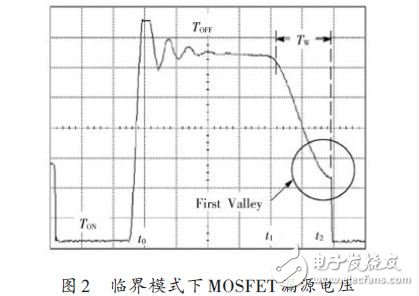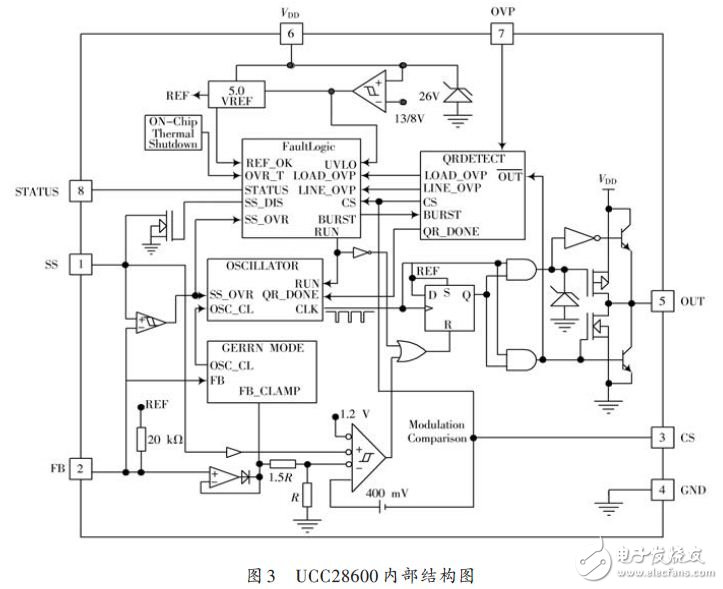In this paper, a design scheme of quasi-resonant flyback switching power supply based on UCC28600 controller is proposed. The scheme analyzes the working principle and implementation of quasi-resonant flyback switching power supply, and gives the circuit and parameter design and selection process. And the actual working switch waveform. Experiments show that the quasi-resonant flyback switching power supply designed in this scheme has the characteristics of wide input voltage range, high conversion efficiency, low EMI, stable and reliable operation. Quasi-resonant technology reduces switching losses in MOSFETs and improves product reliability.
0 Preface
Quasi-resonant conversion is a well-established technology that is widely used in power supply design for consumer products. The new green power series controllers achieve typical ultra-low standby power consumption down to 150 mW. This article will explain how a quasi-resonant flyback converter can improve power efficiency and how to design a quasi-resonant power supply with the UCC28600.
1 conventional hard switching flyback circuit
Figure 1 shows a conventional hard-switching flyback converter circuit. This discontinuous mode flyback converter (DCM) has a duty cycle divided into three operating ranges: (t0 ~ t1) for the transformer to supply energy to the load, at which point the output diode is turned on and the primary current of the transformer passes through Np: The coupling of Ns flows to the output load and gradually decreases.

The MOSFET voltage is superposed by three parts: input DC voltage VDC, output reflected voltage VFB, and leakage inductance voltage VLK. At time t1, the output diode current is reduced to 0. At this time, the primary inductance and parasitic capacitance of the transformer constitute a weak damping. The resonant circuit has a period of 2Ï€ LC . In the stagnation interval (t1~t2), the voltage across the parasitic capacitance changes with oscillation, but always has a fairly large value. At the beginning of the next cycle t2 node, at the beginning of the MOSFET turn-on time, the parasitic capacitance (COSS and CW) will discharge through the MOSFET, creating a large current spike. Since this MOSFET has a large voltage at the time of this current, the current spike is therefore a switching loss. In addition, current spikes contain a large amount of harmonic content, which produces EMI.
2 Implementation of quasi-resonant flyback design
The detection circuit is used to effectively "sense" the first minimum or bottom of the MOSFET drain-to-source voltage (VDS) and only initiate the MOS-FET on-time at this time, since the parasitic capacitance is charged to the lowest voltage, The current spikes will be minimized. This condition is often referred to as Valley Switching or quasi-resonant switching. This power supply is a variable frequency system that is dictated by input voltage/load conditions. In other words, the adjustment is made by changing the operating frequency of the power supply, regardless of the load or input voltage at that time, the MOSFET is always on at the bottom of the valley. This type of work is between continuous (CCM) and discontinuous condition mode (DCM). Therefore, a converter operating in this mode is said to operate in a critical current mode (CRM). The drain-source voltage of the MOSFET in critical mode is shown in Figure 2.

The use of a quasi-resonant switching scheme in flyback power supply design has many advantages:
(1) Reduce conduction loss
Since the MOSFET is turned on with a minimum drain-source voltage, the on-current spike can be reduced. Reduces the pressure on the MOSFET and lowers the temperature of the device.
   (2) Reduce the reverse recovery loss of the output diode
Since the zero current of the rectifier on the secondary side is turned off, the reverse recovery loss is reduced, thereby improving the overall efficiency of the power supply.
(3) Reduce EMI
The reduction in the on current spike and the presence of frequency jitter during quasi-resonance will reduce EMI noise, which reduces the number of EMI filters used, thereby reducing power costs.
3 Design of tungsten lamp power supply based on UCC28600 controller
3.1 Main features of the UCC28600 controller
The main features of the UCC28600 controller are advanced green mode control; low EMI and low loss (valley switch) quasi-resonant control; no-load loss less than 150 mW (low standby current); low starting current (maximum 25 μA); Programmable overvoltage protection (input voltage and output voltage); built-in over-temperature protection, automatic restart after temperature recovery; current limiting protection: cycle-by-cycle power limit, overcurrent slamming restart; programmable soft start; integrated green state foot ( PFC enable).
3.2 How does UCC28600 work?
The UCC28600 integrates a UVLO comparator, a high frequency oscillator, a quasi-resonant controller and a soft start controller, a standby mode skip pulse comparator, and input and output overvoltage protection. Its internal structure is shown in Figure 3.

(1) UVLO comparator
The UCC28600's VDD voltage starts at 13 V, turns off at less than 8 V, and has a 5 V hysteresis voltage to improve the stability of the UCC28600.
(2) Internal oscillator
The UCC28600 integrates a 40~130 kHz oscillator.
(3) Quasi-resonant controller and soft start controller
The UCC28600 uses a quasi-resonant switching converter to improve the conversion efficiency. The excitation flux of the transformer is used to detect the output voltage of the transformer winding during the off period of the switch. If the voltage is low and the valley is oscillating, the transformer excitation can be confirmed at this time. The flux is exhausted and the next cycle can be turned on. The quasi-resonant mode can be divided into a critical conduction mode (CRM) and a discontinuous conduction mode (DCM) and a frequency modulation mode (FFM).
(4) Standby mode and skip pulse comparator
When the power continues to decrease, the UCC28600 enters standby mode; the frequency modulation mode (FFM) frequency drops to 40 kHz and no longer decreases; when FB is less than 0.6 V, the switching pulse output turns off, and when FB is greater than 0.7 V, the switching pulse Normal output, thus getting the standby mode of the skip mode.
(5) Input and output overvoltage protection
The OVP pin is an overvoltage (line voltage and load voltage) input pin and a resonant open response pin. This pin detects the input overvoltage, load overvoltage and resonance conditions through the transformer primary bias coil, and the overvoltage point can pass. The resistor connected to this pin is flexibly adjusted.
3.3 Technical Specifications of Tungsten Lamp Power Supply
Input voltage: 95~260 V AC 50/60 Hz; output voltage: 5 V; output current: 4.3 A; the power output can be turned off remotely.
Quickly brew the perfect cup of tea or make pour over coffee right at the table with the Electric Tea Kettle. With 1500 watts, this Electric Kettle boils water faster than a microwave, and is safer to use than a stovetop kettle because it automatically turns off when the water reaches a boil. Serving at the table is no problem as the kettle lifts off the base without the cord. Additional features include two water level windows and a pull-lid to make filling and serving easy.
Features:
- Thermostat Control – Having a thermostat control allows the kettle to [know" when to shut off. This will prevent damage to the heating element and is an important feature in all modern styles.
- Auto shut off/Boil Dry Protection/Fuse – these are three features that are great for protecting the safety of users as well as extending the life of the electric kettle. The fuse and boil dry protection shut the kettle off if the water gets down below a certain level or if it`s left on for an extended period of time, It doesn`t burn up the kettle.
- Colors and Designs – Electric kettles come in all shapes, sizes and colors. Finding one that will fit with the kitchen design is actually pretty easy. Finding one that matches and that has the features you`re looking for can be a bit harder, but with all the choices available and the newer models on the market today, you will be able to find the perfect electric kettle for your kitchen.
- Savety in Electric- the heating element is typically fully enclosed, with a power rating of 2–3 kW at 220V. In countries with 110V mains electricity, kettles may be less powerful (1–1.5 kW) to avoid drawing too much current and requiring a very thick supply wire.
Application:
Heat the tea thoroughly
Bottle the water/beer
Boil water
Electric Tea Kettle
Electric Tea Kettle,Stainless Steel Electric Tea Kettle,Cordless Electric Tea Kettle,Electric Cordless Glass Tea Kettle
Guangzhou Taipeng Electrical Appliances Technology CO., LTD. , https://www.kettles.pl